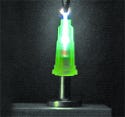January 18, 2007
Originally Published MPMN January/February 2007
PRODUCT UPDATE
Developments in Surface Treatments
To serve and protect: polymer coatings and plasma systems benefit devices
Many forms of surface treatment are useful for medical devices. In the following article MPMN reports on some recent developments in the area. First, we present a real-life example of how a company developed a parylene coating process. Then, we cover two companies that supply plasma systems and performance coatings.
|
After the coating process, PTC inspects samples to ensure tight tolerances. The entire batch is rejected if any out-of-tolerance film thicknesses, surface defects, or overcoated contaminants are found. |
Parylene Coating Protects Fine Wires Used in Cochlear Implants
Thin wires are used in cochlear implants to transmit auditory information from the device to the cochlear nerve. The wire must be protected by a coating of a precise thickness that is free of surface irregularities, voids, and pinholes. The coating must also be suitable for permanent implantation in the body, exhibit good adhesion, and withstand stresses of implantation and use.
Parylene is used as a protective coating in medical applications, including prosthetics, catheters, cardiac assist devices, transducers, and needles. The FDA-approved, USP Class VI polymer has high molecular weight and an all-carbon backbone. The deposited film has useful dielectric properties, even in very thin layers. It is resistant to moisture, chemicals, organic solvents, acids, and reagents. With this in mind, Advanced Bionics (Sylmar, CA), a manufacturer of cochlear implants, chose parylene for electrode protection. The company teamed with Para Tech Coating Inc. (PTC; Aliso Viejo, CA) to develop the coating process.
PTC faced several challenges with the Advanced Bionics coating application. The parylene needed to be applied at a target thickness with an acceptable variation of ±1 µm. In addition, the deposited film had to be uniform and free of minute entrapped con- taminants or coating nodules.
The process begins with bare wire being shipped to the PTC coating center in 1000-ft rolls. The wire is then wound onto rectangular coating fixtures for placement in the vacuum coating chamber. Using several proprietary vacuum-deposition refinements, PTC can meet the thickness and uniformity specifications in a production setting.
The company’s parylene deposition process is controlled via computer-controlled time and temperature adjustments, rather than cyclic variations in vacuum levels. This technique allows film properties to be fine-tuned based on the requirements of the substrate. It avoids the thermal excursions, coating bursts, and unpredictable cycle length of traditional parylene process control.
|
Wire electrodes are parylene coated by PTC for use in cochlear implants. |
After the coating cycle, the parylene film thickness is measured. A spectrometer is used to determine an average film value across the chamber for the cycle. Six randomly selected segments of coated wire from the batch are also inspected at 80¥ magnification to assess film clarity, uniformity, and freedom from surface anomalies. The entire batch is rejected if any out-of-tolerance film thicknesses, surface defects, or overcoated contaminants are found in the sample.
The finished electrode wires require special care during handling to avoid contamination and breakage. All work is accomplished under a filtered airflow hood, including fixture winding, postcoat inspection, and packaging for return to the customer.
PTC is certified to ISO 9001:2000 standards and maintains parylene drug and device master files with FDA that contain data on biological studies pertaining to the company’s parylenes’ performance. Parylenes N and C supplied by PTC also comply with USP biological testing requirements for Class VI plastics.
Complex Parts Get Special Treatment from Plasma System
Corotec Corp. (Farmington, CT) offers a pulsed-plasma system that was designed specifically for treating hard-to-reach surfaces of medical devices. The system can be used to treat the insides of plastic hubs that hold hypodermic needles and dispensing nozzles.
The pulsed-plasma system can treat a variety of parts that would be difficult or impossible to treat with conventional corona, flame, or other means. It can treat up to 20 parts per second or more, depending on the particular application.
|
A pulsed-plasma treatment system from Corotec Corp. is designed for use with hard-to-treat medical components. |
“The pulsed-plasma treating system treats the inside surface of small areas that conventional systems cannot access,” says Bruce Stobbe, company president. “For instance, the system can be used with a plastic hub that is used to hold the needle for a syringe. The hub has a very small hole where the needle is inserted and glued into place. Treating the inside of the small hole greatly improves the bond between the hub, needle, and the adhesive.”
The system is the latest addition to the Corotec line of treating equipment fo r medical applications. All products in the series are designed to improve the bonding of inks, adhesives, and coatings. The company offers a variety of solutions for surface treatment of medical components, including the Plasma-Jet system for 3-D parts.
Corotec also supplies a line of standard and custom corona-discharge surface-treating equipment for narrow-web and wide-web applications, systems for controlled atmosphere testing, and ozone generators for coating and laminating processes and other applications.
Performance Coatings Add Resistance, Other Benefits
Performance coatings can enhance corrosion or chemical resistance, provide electrical insulation or nonwetting characteristics, or add dry lubrication. Applied Plastics Inc. (Norwood, MA) has designed its specialty coatings to add specific surface properties to parts. Typical coatings include Teflon for high lubricity as well as nonstick and nonwetting properties at up to 550°F, and Kynar, which exhibits superior strength and toughness. Halar coatings can be used for electrical insulation, and nylon is offered for impact, corrosion, and abrasion resistance.
Copyright ©2007 Medical Product Manufacturing News
You May Also Like





